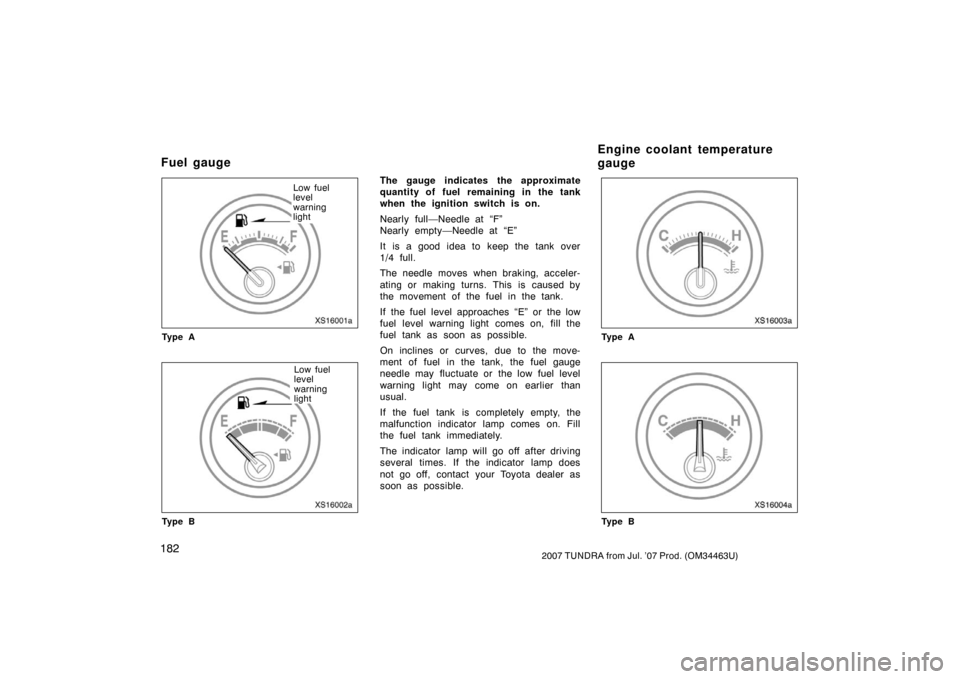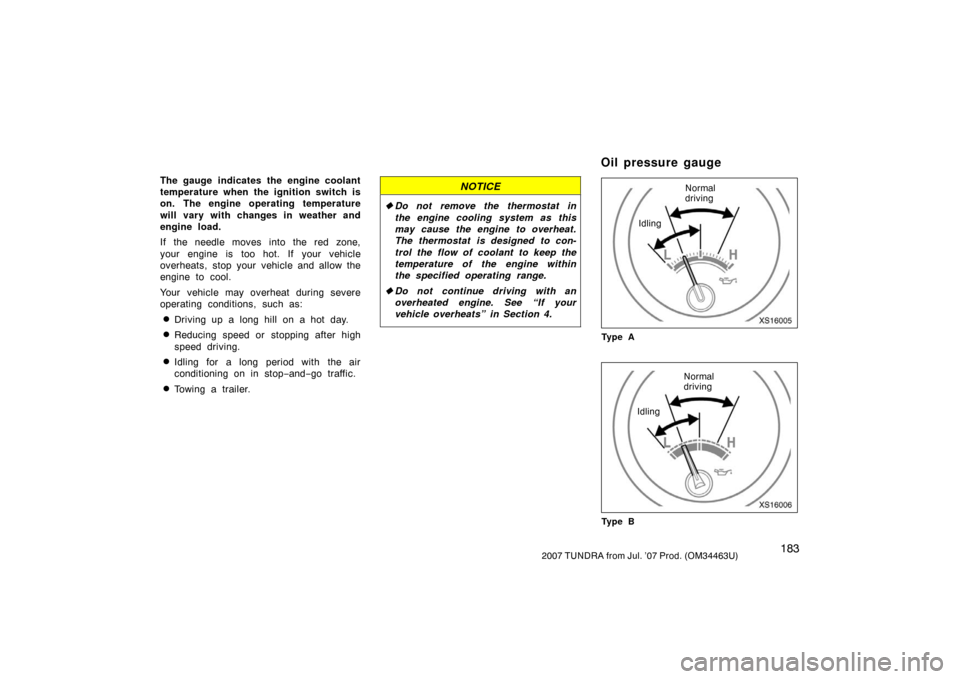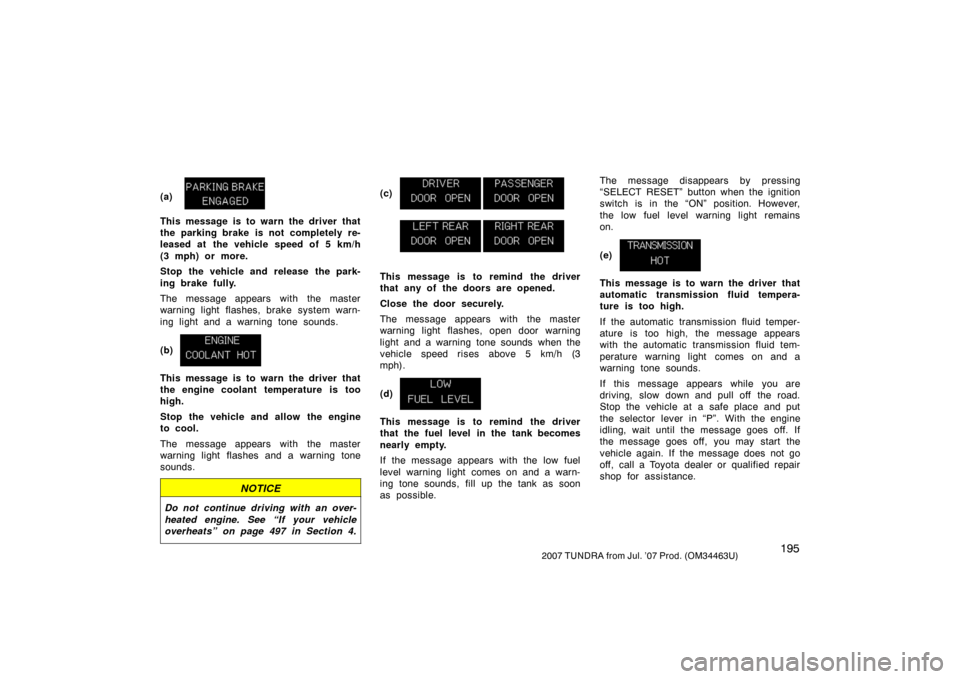Page 21 of 611
122007 TUNDRA from Jul. ’07 Prod. (OM34463U)
XS11002c
1. Tachometer
2. Service reminder indicators andindicator lights
3. Speedometer
4. Fuel gauge 5. Voltmeter
6. Oil pressure gauge
7. Engine coolant temperature gauge
8. Trip meter reset knob
9. Odometer and two trip meters10. Automatic transmission shift position
indicator lights
11. Automatic transmission shift range display
12. Automatic transmission fluid temperature gauge
Instrument cluster overview
�Ty p e A
Page 22 of 611
132007 TUNDRA from Jul. ’07 Prod. (OM34463U)
XS11003c
1. Tachometer
2. Service reminder indicators andindicator lights
3. Speedometer
4. Fuel gauge 5. Voltmeter
6. Oil pressure gauge
7. Engine coolant temperature gauge
8. Trip meter reset knob
9. Multi
−information display 10. Automatic transmission shift position
indicator lights
11. Automatic transmission shift range display
12. Automatic transmission fluid temperature gauge
�
Ty p e B
Page 190 of 611

1812007 TUNDRA from Jul. ’07 Prod. (OM34463U)
OPERATION OF INSTRUMENTS AND
CONTROLS
Gauges, Meters and Service reminder indicators
Fuel gauge182
. . . . . . . . . . . . . . . . . . . . . . . . . . . . . . . . . . . . .\
. . . . . . . . . . .
Engine coolant temperature gauge 182
. . . . . . . . . . . . . . . . . . . . . . . . . . .
Oil pressure gauge 183
. . . . . . . . . . . . . . . . . . . . . . . . . . . . . . . . . . . . \
. . . . .
Automatic transmission fluid temperature gauge 184
. . . . . . . . . . . . . . .
Vo ltme te r 185
. . . . . . . . . . . . . . . . . . . . . . . . . . . . . . . . . . . . \
. . . . . . . . . . . . . .
Tachometer 185
. . . . . . . . . . . . . . . . . . . . . . . . . . . . . . . . . . . . \
. . . . . . . . . . . .
Odometer and two trip meters 186
. . . . . . . . . . . . . . . . . . . . . . . . . . . . . . . .
Multi −information display 187
. . . . . . . . . . . . . . . . . . . . . . . . . . . . . . . . . . . . \
Service reminder indicators and warning buzzers 197
. . . . . . . . . . . . . .
SECTION 1� 6
Page 191 of 611

1822007 TUNDRA from Jul. ’07 Prod. (OM34463U)
XS16001a
Low fuel
level
warning
light
Ty p e A
XS16002a
Low fuel
level
warning
light
Ty p e B
The gauge indicates the approximate
quantity of fuel remaining in the tank
when the ignition switch is on.
Nearly full—Needle at “F”
Nearly empty—Needle at “E”
It is a good idea to keep the tank over
1/4 full.
The needle moves when braking, acceler-
ating or making turns. This is caused by
the movement of the fuel in the tank.
If the fuel level approaches “E” or the low
fuel level warning light comes on, fill the
fuel tank as soon as possible.
On inclines or curves, due to the move-
ment of fuel in the tank, the fuel gauge
needle may fluctuate or the low fuel level
warning light may come on earlier than
usual.
If the fuel tank is completely empty, the
malfunction indicator lamp comes on. Fill
the fuel tank immediately.
The indicator lamp will go off after driving
several times. If the indicator lamp does
not go off, contact your Toyota dealer as
soon as possible.
XS16003a
Ty p e A
XS16004a
Ty p e B
Fuel gaugeEngine coolant temperature
gauge
Page 192 of 611

1832007 TUNDRA from Jul. ’07 Prod. (OM34463U)
The gauge indicates the engine coolant
temperature when the ignition switch is
on. The engine operating temperature
will vary with changes in weather and
engine load.
If the needle moves into the red zone,
your engine is too hot. If your vehicle
overheats, stop your vehicle and allow the
engine to cool.
Your vehicle may overheat during severe
operating conditions, such as:
�Driving up a long hill on a hot day.
�Reducing speed or stopping after high
speed driving.
�Idling for a long period with the air
conditioning on in stop−and− go traffic.
�Towing a trailer.
NOTICE
�Do not remove the thermostat in
the engine cooling system as this
may cause the engine to overheat.
The thermostat is designed to con-
trol the flow of coolant to keep the
temperature of the engine within
the specified operating range.
� Do not continue driving with an
overheated engine. See “If your
vehicle overheats” in Section 4.
XS16005
Normal
driving
Idling
Ty p e A
XS16006
Normal
driving
Idling
Ty p e B
Oil pressure gauge
Page 202 of 611
1932007 TUNDRA from Jul. ’07 Prod. (OM34463U)
MessageStatusAction
(a)Parking brake is not released.Release parking brake.
(b)Engine coolant temperature is too high.Stop your vehicle and allow engine to cool.
(c)Any of doors are opened.Close doors completely.
—Warning messages
Page 204 of 611

1952007 TUNDRA from Jul. ’07 Prod. (OM34463U)
(a)
This message is to warn the driver that
the parking brake is not completely re-
leased at the vehicle speed of 5 km/h
(3 mph) or more.
Stop the vehicle and release the park-
ing brake fully.
The message appears with the master
warning light flashes, brake system warn-
ing light and a warning tone sounds.
(b)
This message is to warn the driver that
the engine coolant temperature is too
high.
Stop the vehicle and allow the engine
to cool.
The message appears with the master
warning light flashes and a warning tone
sounds.
NOTICE
Do not continue driving with an over-
heated engine. See “If your vehicle
overheats” on page 497 in Section 4.
(c)
This message is to remind the driver
that any of the doors are opened.
Close the door securely.
The message appears with the master
warning light flashes, open door warning
light and a warning tone sounds when the
vehicle speed rises above 5 km/h (3
mph).
(d)
This message is to remind the driver
that the fuel level in the tank becomes
nearly empty.
If the message appears with the low fuel
level warning light comes on and a warn-
ing tone sounds, fill up the tank as soon
as possible.The message disappears by pressing
“SELECT RESET” button when the ignition
switch is in the “ON” position. However,
the low fuel level warning light remains
on.
(e)
This message is to warn the driver that
automatic transmission fluid tempera-
ture is too high.
If the automatic transmission fluid temper-
ature is too high, the message appears
with the automatic transmission fluid tem-
perature warning light comes on and a
warning tone sounds.
If this message appears while you are
driving, slow down and pull off the road.
Stop the vehicle at a safe place and put
the selector lever in “P”. With the engine
idling, wait until the message goes off. If
the message goes off, you may start the
vehicle again. If the message does not go
off, call a Toyota dealer or qualified repair
shop for assistance.
Page 219 of 611

2102007 TUNDRA from Jul. ’07 Prod. (OM34463U)
(b) Normal driving1. Start the engine as instructed in “How to start the engine” on page 468 in
Section 3. The transmission must be in
“P” or “N”.
When the front drive control switch knob
is in “4L” (low −speed position, four −wheel
drive), the driving pattern selector setting
has no effect on gear shift timing. (See
“Four −wheel drive system” on page 239 in
this Section for information of the front
drive control lever.)
2. With your foot holding down the brake pedal, shift the selector lever to “D”.
When the lever is in the “D” position, the
automatic transmission system will select
the most suitable gear for running condi-
tions such as normal cruising, hill climb-
ing, hard towing, etc.
Always use the “D” position for better fuel
economy and quieter driving. If the engine
coolant temperature is low or when the
front drive control switch knob is in “4L”
(low −speed position, four −wheel drive), the
transmission will not shift into the over-
drive gear even in the “D” position. (See
“Four −wheel drive system” on page 239 in
this Section for information of the front
drive control.)CAUTION
Never put your foot on the accelera-
tor pedal while shifting.
3. Release the parking brake and brake pedal. Depress the accelerator pedal
slowly for smooth starting.
AI (Artificial Intelligence) shifting con-
trol—
AI shifting control selects the most
suitable shift range automatically ac-
cording to the driver’s operation and
driving condition.
AI shifting control operates automatical-
ly with the selector lever in the “D”
position. When the lever is moved to
the “S” position, this function will be
cancelled.
�Shifting control on the slope:
On inclines, you can drive smoothly
with reduced shifting quantity. On de-
clines, the vehicle will shift down auto-
matically to obtain optimum engine
braking and reduce the driver ’s foot
braking load.
�Automatic shifting point change con-
trol:
The most suitable shift range is se-
lected depending on the driver ’s accel-
erator pedal operation and vehicle con-
dition.
(c) Driving in “S” mode
The shift range position can be
changed in “S” mode. When the selec-
tor lever is in the “S” position, the
shift range position can be switched
between “5” (fifth range) and “1” (first
range) by shifting the selector lever to
the “+” (up) or “�” (down) position. By
shifting the lever to the “+” (up) posi-
tion and holding it for at least 1 sec-
ond, the highest shift range position
can be obtained. However, it cannot be
changed while cruise control is acti-
vated. When the selector lever is
shifted to the “S” position, shift range
position “4” (fourth range) is selected
automatically.
However, if the selector lever is shifted
to the “S” position when AI shifting
control is being performed, the initial
shift range position may be “3” (third
range). This is because the suitable
shift range is selected depending on
the driving condition.